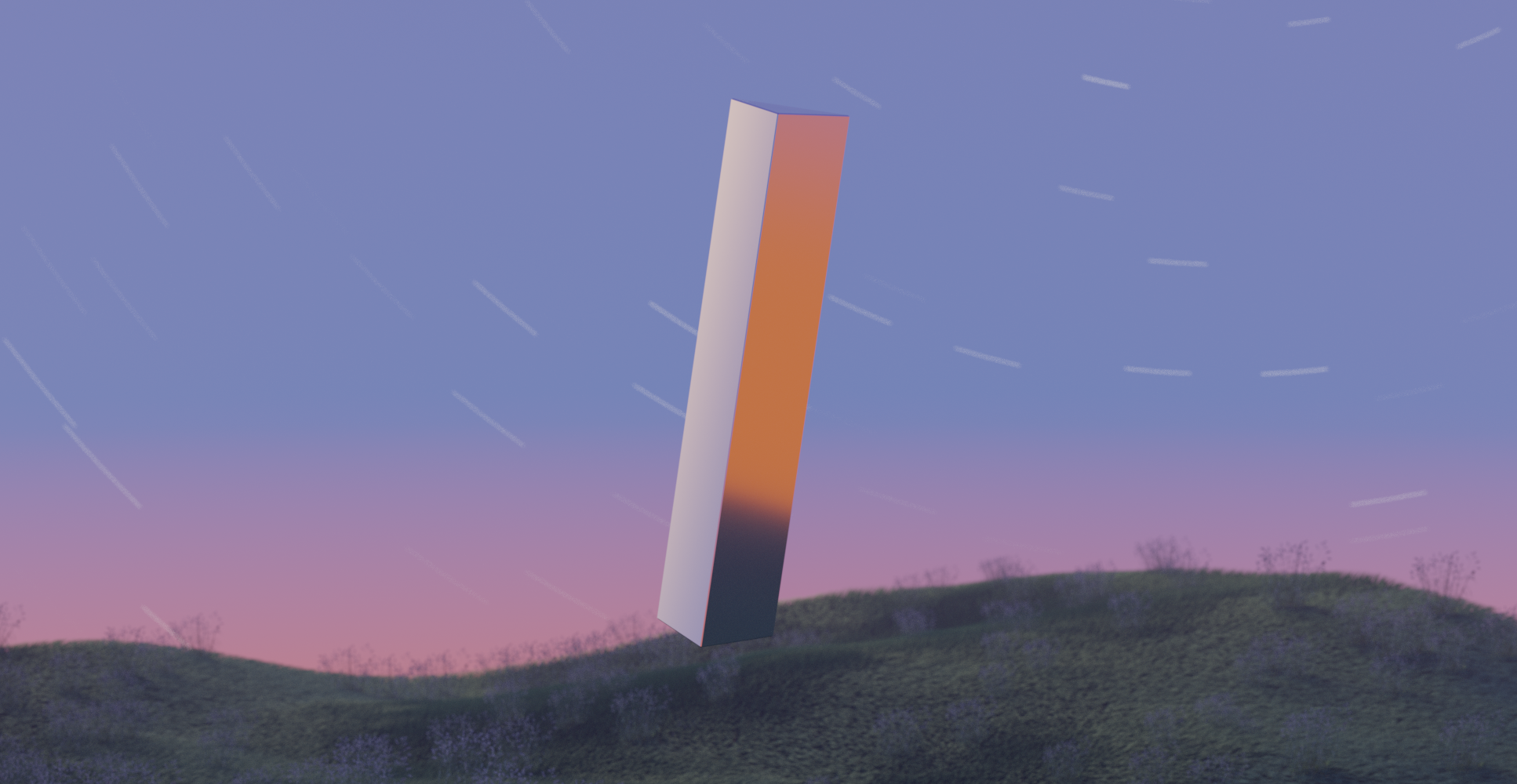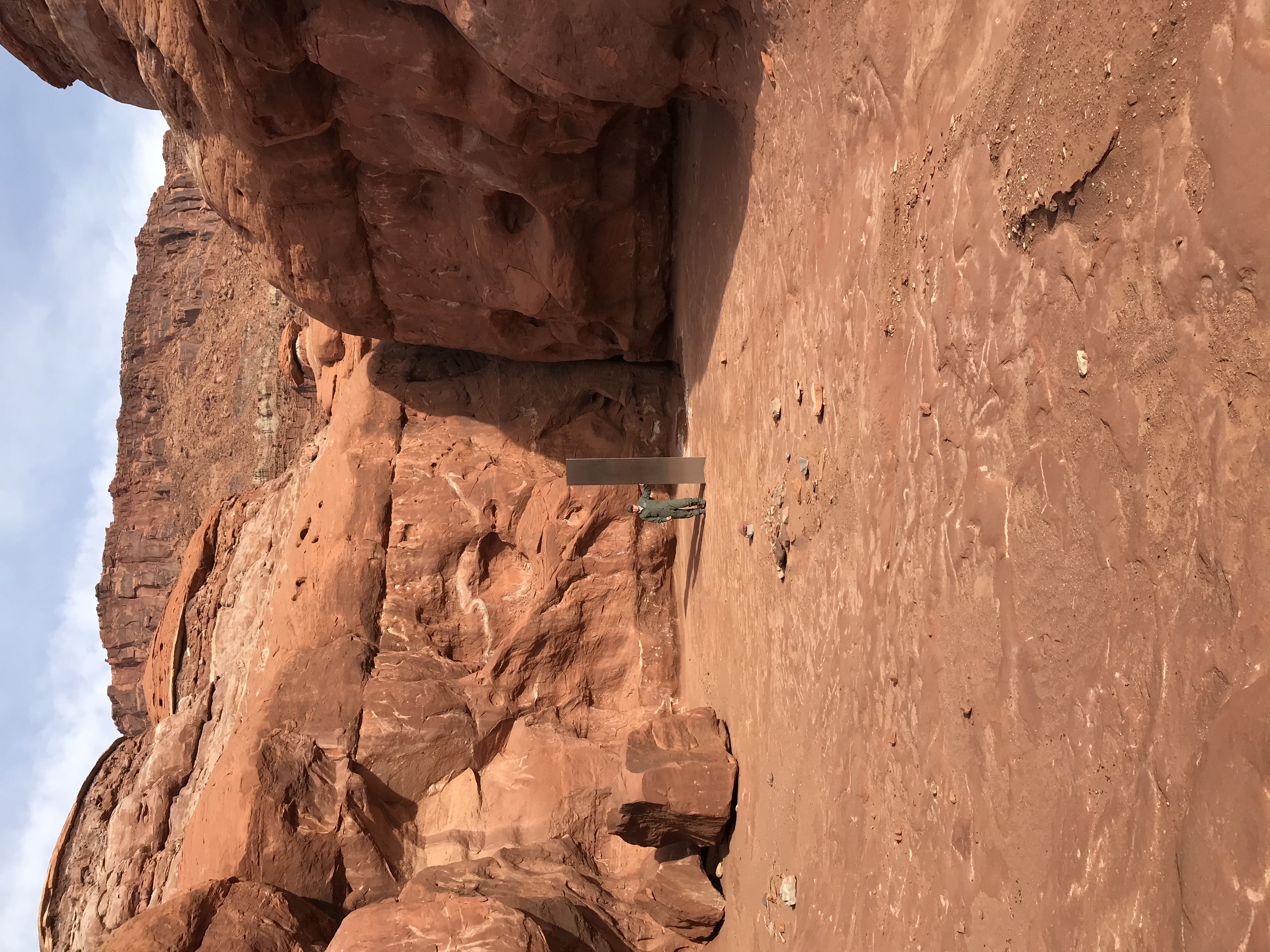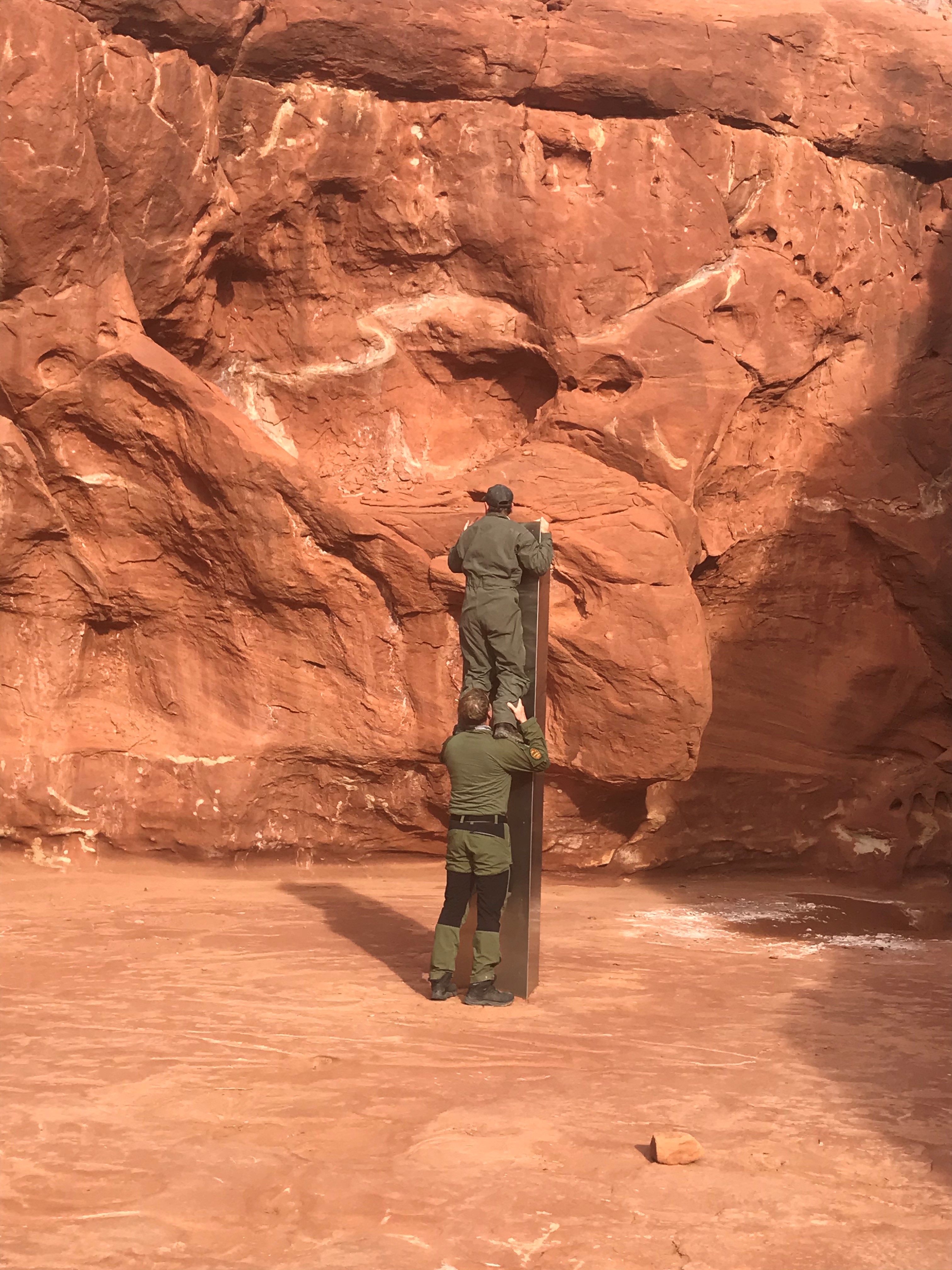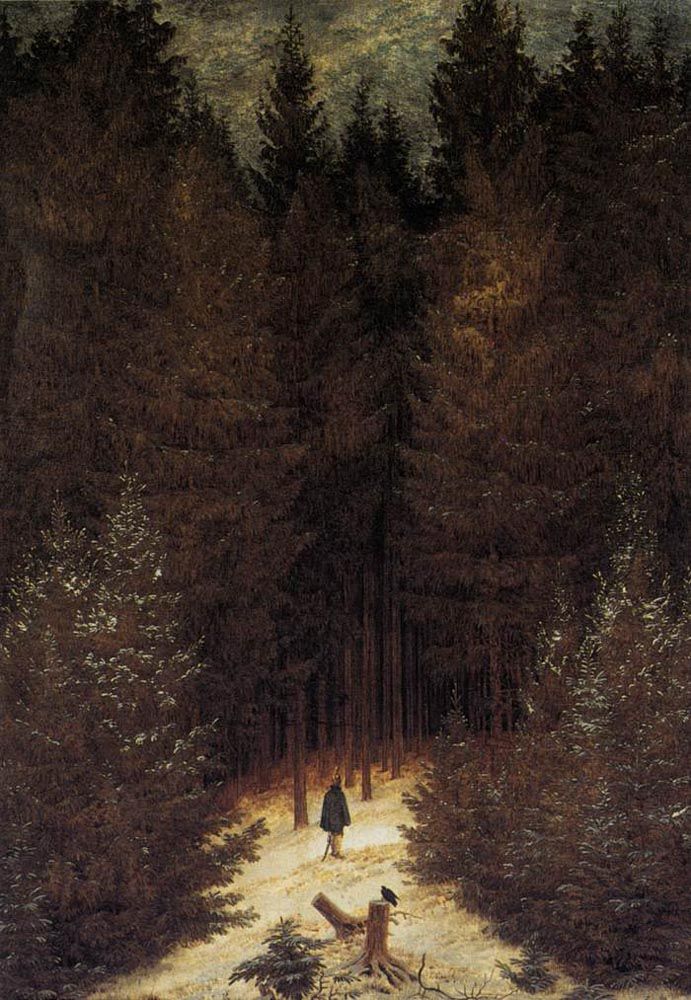It’s Probably Art
The Utah Monolith and the American Landscape

The Utah Monolith stood at 38°20'35.18" North, 109°39'58.32" West in Red Rock Country, Utah, on a piece of flat ground between two diverging rock faces. It was installed there by an unknown artist sometime in 2016 (that's when it appears in satellite images), discovered by wildlife officials on November 23, 2020, and removed ten days later by four unknown men.1
It was ten to twelve feet tall, and made of polished sheet metal riveted together along the edges, forming a slender, triangular column. Until its removal, the structure was embedded (possibly cemented) into a hole of the same cross section, probably cut into the hard ground with a concrete saw.
In the handful of photographs that exist of the monolith, its formal beauty is clearly visible: Its geometric form, sharp corners and flat sides, the silvery shine of its metal surface form a striking contrast to the weathered, reddish-brown rock of the surrounding landscape. The sculpture is framed by the near-vertical rock face on either side; the symmetry gives the scene a feeling of gravity, like a shrine carved from the earth.
The monolith related, too, to the park rangers (and later, the handful of ambitious hikers) encountering it. Its height of twelve feet - twice as tall as the average man - looks like an artistic choice rooted in classical ideas of proportion. It's not a million miles away from a Greek column.
But this sense of aesthetic familarity is unsettled by the apparent lack of any material relation between the monolith and the earth around it. Apart from the conspicuous absence of vegetation, the ground bears no obvious signs of work. There is no plinth; the monolith has no base or visible support; it's as if it had simply emerged from the earth already in its finished, inert state. Its matte surface looks too flawless for an object exposed to the elements, and produces little reflection of the surrounding landscape. If it weren't for the faintly visible rivets, and a small mound of loose earth by its base, you might mistake it for a misplaced video game asset clipping through the ground from another realm.
As you observe it, the monolith seems to oscillate between these two modes of dialogue with its surroundings - one rooted in familiar elements of composition and proportion, the other in its otherwordly materiality - never quite reaching an equilibrium.
Like most people, I learned about the monolith from the news. The New York Times’ opening paragraph – "A team surveying bighorn sheep for Utah’s wildlife agency found the strange object, 10 to 12 feet tall, embedded in the ground in a remote part of Red Rock Country. It’s probably art, officials said" - sounded too much like the fake news reports at the beginning of a disaster fiction film to be ignored.
The rest of the story was uneventful, consisting mostly of statements from local officials confirming that they had no idea what the object was or how it got there, either. They declined to give the precise location of the monolith for fear of potential visitors becoming stranded in the remote desert and needing rescue.
As I read through these non-statements, I couldn’t help but imagine the rest of the movie evoked by that first paragraph:
EXT. DESERT - MORNING
GENERAL: How long ‘till we get this goddamn thing dug up?
Govenor wants it gone before the tourists start showin’ up.
SCIENTIST: Sir, we’ve been digging all night, but it
doesn’t seem to, uh, end…
GENERAL: You mean to tell me it goes all the way through
the earth? Are you out of your mind lieutenant?Cut to a research ship on the Indian ocean, on the opposite side of the Earth, you get the idea.

IMG_3534
For all its sculptural qualities, most of us never experienced the monolith as a sculpture, but as photographs of one, appearing (to paraphrase the art critic John Berger) not on the austere walls of a gallery, but the screens of our phones and laptops in our homes.
We have been looking at works of art in this way for a long time: Berger wrote his seminal book Ways of Seeing in 19722, when television sets had just entered the home, and Walter Benjamin saw the trend in the 19th century, when photo-engraving had made the mass-reproduction of paintings possible for the first time. But usually there is at least the option (however theoretical) to go see a work in person. This wasn't the case with the monolith - not only was it installed in an inaccessible location, but we've been confined to our homes for months; and travel between states, let alone countries is a distant memory for most of us.
All we have are the four still photographs and three short videos of the sculpture released by the Utah Department of Public Safety3 (I'll refer to them here by their filenames).
In Monolith.mp4, which appears to be the first in the sequence, we see three men in green overalls descending a slope and walking slowly toward the monolith. The fourth man, who is holding the camera, comments: "Okay, the intrepid explorers go down to investigate the, uh, alien life form". In the following images4 the camera has followed the men down the slope, and we see them examining the monlith closer. Though the camera moves around throughout the sequence, we always see the monolith from a more or less frontal perspective.

IMG_3946
3946 is particularly evocative. We see two men, both wearing olive-green overalls and heavy boots, forming an element of repetition against the singular monolith. The worn rock face fills the background. One the men stands on the other's shoulders; his head reaching just above the monolith. He is holding two corners of the monolith to stablise himself as he turns slightly toward the left, looking across the top of the monolith at a point on the rock wall a few feet away. The mobile phone's camera brings the entire scene into sharp focus.
It's perhaps the image that most effectively captures the sublime element of the scene - that elusive quality of physical, spiritual, and aesthetic greatness beyond human comprehension sought by artists since the 18th century.5 Here we see two men doing their very best to understand the object in front of them; we might even read the act of standing on one another's shoulders as a metaphor for the scientific method. But on top of the monolith, there is no knowledge to be found - only the towering, impenetrable, ancient rock face beyond.

Caspar-David Friedrich: The Chasseur in the Forest (1814). Oil on canvas, 66×47cm. Private collection.
Public Domain, via Wikimedia Commons
This sense of awe in the face of Nature is often associated with works by the English painter J. M. W. Turner (1775-1851), but he never did much for me (maybe I grew up too far from the sea). I recognise it more easily in the stillness of a painting like Caspar David Friedrich's Chasseur in the Forest (1814). Here, too, the human figure shrinks away against an overwhelming landscape, the black trees resisting any attempt at enlightenment.
The Monolith's location didn't stay secret for long. Less than a day after the Times published their story, a Reddit user named Bear__Fucker had found the monolith on Google Earth6, using public data about the helicopter’s flight path and clues like the colour of rock, and the shape of the hills in the distance visible in the published photographs.
After a few failed attempts at getting the link to load up on my laptop, I copied their coordinates and went looking for the place myself. The ten minutes I spent moving my cursor slowly across the endless Utah desert while eyeing the position display in the corner of the screen were strangely exhilerating; like a real-life treasure hunt with a supernatural undercurrent.
Finally it appeared: a thin black line across the washed-out ground. Here was proof that the thing really existed, and had done for years.
It occured to me that the monolith was just the right size to be viewed by satellite: large enough to be clearly visible in public images without revealing too much of the mystery. It reminded me of those satellite calibration targets elsewhere in the desert.7
It's no accident, I think, that the images of the monolith are so compelling: The scene feels like it was always designed to be photographed.
Its romantic symmetry only works from "the front", so that's where the photographer naturally positions themselves. The monolith's scale keeps them from getting too close, cropping it would look wrong. Even the lighting was considered: had the monolith been placed a few feet back, it would disappear in the shadow.
In this view, the monolith is less of a sculpture and more of a prop in an elaborate outdoor set. The wildlife officials and hikers become unwitting extras.
The Monolith toppled
Michael James Newlands / The New York Times
In fact, the cellphone images of the toppled Monolith show that it was built exactly like the prototypical Hollywood prop: not of solid metal, but thin sheets of aluminium mounted to a hidden plywood frame 8.
From here it's only a small leap to an earlier version of the same prop: the alien monolith in Stanley Kubrick's 2001 (1968). It was twelve feet tall (just like the Utah Monolith, and the pyramid in Arthur C. Clarke's original short story9), though of a different cross-section and made of wood covered in black paint and graphite powder.10 It appears in each of the film’s four episodes, but the first two seem most significant here: Against the background of a prehistoric desert landscape, among a group of hominids at the dawn of civilisation, and later at the bottom of a starkly-lit excavation site on the Moon, surrounded by weary astronauts.
We clearly see the impact of Kubrick's photography on whoever set up the Utah Images. The shock of the sharp-edged, artificial object against the weathered landscape, the group of weary explorers decending towards it, even the spacesuits are mirrored here. The reference is so clear that the man holding the camera in Monolith.mp4 recognises it within seconds.
Kubrick’s film in turn follows photographs and paintings of the sublime landscape of earlier periods, both in its theme and its aesthetics. I wouldn't be surprised to find a photocopy of The Chasseur somewhere in Kubrick's vast archive.11
But the chain of influence runs the other way, too: Our whole notion of The Landscape, and in some cases its physical reality are themselves cultural productions. In the 18th century, European aristocrats planted trees, dug lakes, and built prop ruins of Greek or Roman temples to bring their land closer to what they had seen in paintings of their day.12
In the 19th century photography, having inherited the visual language of painting, helped shape the fantasy of the great, "untouched" American landscape that still lingers today. Photographers like Carleton Watkins didn’t “discover” places like Yosemite Valley, but constructed them with complex optical machinery and painstaking work in the darkroom.13
2001's Star Gate sequence (1968)
In 1968, those familiar images of the American Landscape re-appear in 2001’s terrifying Star Gate sequence. As we're transported through interstellar space, we see them disfigured by swirling photochemicals and distorted glass, all dissolving into a pool of pure, acidic colour. It’s the ultimate upside-down of the stately silver-gelatin prints of the previous century, but the lineage is there nontheless.
Kubrick shot that sequence just a hundred miles south of where the Utah Monolith appeared sometime in 2016: The latest statement in a century-long dialogue between image-making and the landscape.
Over the following days, I kept following the news stories about the monolith. There was the question of attribution: The gallerist David Zwirner made, then walked back a statement saying it was a work by the minimalist sculptor John McKracken (who's estate Zwirner happens to represent).14 A few other artists where floated, but swiftly issued denials.
A handful of social media users went to see the monolith in real life, including one ex-military man who drove 200 miles through the night to be there first (I admire the commitment).15
Finally it disappeared, ten days after it was discovered. According to a couple of eyewitnesses, four men made it "their mission" to return the landscape to its "natural state"16, itself an act loaded with aesthetic and linguistic baggage. I don't exactly know how to feel about it. On one hand it feels like a loss; I enjoyed the idea of this unexplained object out there in the desert, unaffected by the world around it - as a friend of mine put it in a text message, it’s nice to feel an ounce of magic in a shitty time.
But on the other hand, I think the monolith's appeal was never really about the physical thing anyway; that was just a prop. What’s more important is the cultural output inspired by it: the images, videos, news reports, collective speculation, and even the after-dark performance of its destruction. That collective body of work survives.
In this year of never-ending crisis, where any attempt to look more than a few days into the future seems utterly hopeless, and our movements have become small and repetetive, the Utah Monolith managed what many online art experiences struggled to do: For a moment, it led our gaze, and our mind away from the world immediately in front of us: up, toward the stars ★
Alan Yuhas / The New York Times (2020): A Weird Monolith Is Found in the Utah Desert ↩︎
John Berger (1972): Ways of Seeing. Penguin Books. ↩︎
Utah Department of Public Safety (2020): DPS Aero Bureau Encounters Monolith in Red Rock Country ↩︎
3526, 3527, 3528, 3532, 3534, 3546, and monolith.jpg. I wonder what happened to the missing files in the sequence. ↩︎
Christine Riding and Nigel Llewellyn (2013), ‘British Art and the Sublime’, in Nigel Llewellyn and Christine Riding (eds.), The Art of the Sublime, Tate Research Publication. ↩︎
Reddit/DOTTheMath (2020): Help me find this obelisk in remote Utah wilderness ↩︎
Atlas Obscura / randalscott: Corona Satellite Calibration Targets ↩︎
Incidentally, you could see this as an argument against the idea that the Monolith is a sculpture by McKracken - his are made of stainless steel. ↩︎
Arthur C. Clarke (1948): The Sentinel, published 1951 as Sentinel of Eternity. Available on the Internet Archive ↩︎
Bruce Handy / Vanity Fair (2014): Weird, Unseen Images from the Making of 2001: A Space Odyssey ↩︎
Jon Ronson / The Guardian (2004): Citizen Kubrick ↩︎
Paul Cooper / The Atlantic (2018): Europe Was Once Obsessed With Fake Dilapidated Buildings" ↩︎
Ana Cecilia Alvarez (2019) in Real Life Magazine: Look for America: How Land became scenery ↩︎
Amanda Holpuch / The Guardian (2020): Theories abound over mystery metal monolith found in Utah ↩︎
Alexandra Mae Jones / CTV News (2020): Hiker drove six hours into Utah desert to see metal monolith before it vanished ↩︎
Serge F. Kovaleski, Deborah Solomon and Zoe Rosenberg / The New York Times (2020): How a Mysterious Monolith Vanished Overnight (It Wasn’t Aliens) ↩︎